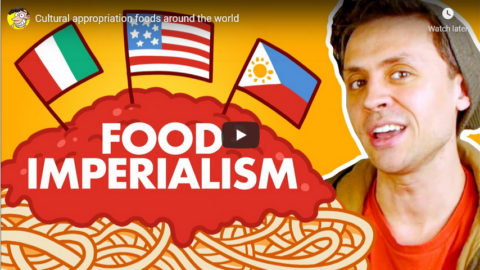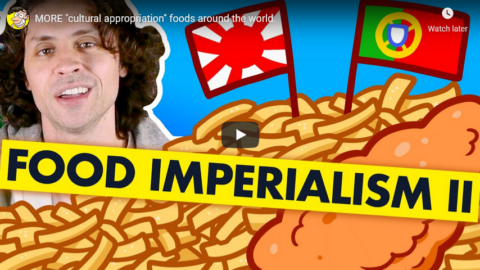Uri Tuchman
Published 12 Jul 2019Preserved lemon recipe:
For the lemons:
– 6 lemons
– 300 gram salt
Cutting board:
– 40x25x1.5 cm cherry wood
Knife:
– 20x5x0.2 cm O1 steel
– 10x3x2 cm Maple wood
– 4x3x2 cm walnut wood
Airtight container:
– 14x14x1.5 cm cherry wood x2
– 10x14x1.5 cm cherry wood x4
– brass screw rod x8
– brass thumb nut x8
Serving board
– 20x6x1.5 cm beech wood
– 6x1x0.5 cm walnut
Fork:
– 6x1x0.2 cm brass plate
– 1cm brass tube
– 10 wooden handle from some nice burlMix everything in a bowl and you’re golden!
Patreon: https://www.patreon.com/urituchman
Instagram: https://www.instagram.com/urituchman/Music:
Acid Trumpet
Kevin MacLeod
incompetech.com)
Licensed under Creative Commons: By Attribution 3.0 License
http://creativecommons.org/licenses/b…
April 1, 2021
How to Make Preserved Lemons in the Workshop
March 22, 2021
The Geography of Spices and Herbs
Atlas Pro
Published 4 Jan 2019Fun fact, I got the idea for this video while working as a cook in a Taco Bar.
Support me on patreon maybe? https://www.patreon.com/atlaspro
“Arroz Con Pollo” Kevin MacLeod (incompetech.com)
Licensed under Creative Commons: By Attribution 3.0 License
http://creativecommons.org/licenses/b…
March 21, 2021
The two Britains, gastronomically speaking
Theodore Dalrymple on the British diet (at least before the neverending lockdowns):

“The Joy of Cookbooks” by shoutabyss is licensed under CC BY 2.0
As in many other things, the population has divided into two: those with increasingly refined tastes in gastronomy, and those who eat mainly junk and takeaway food for the quickest but also crudest possible gratification.
Gastronomy often seems the only aesthetic sphere in which the modern British display any real interest. Their dress, their music, their art (or at least such as gains any publicity), their literature, and of course their architecture, are hideously ugly, even militantly so, but a Michelin-starred restaurant receives their adulation — or did in the now-distant days when restaurants were open.
But the modern interest in food is not the same as a mass market for fish, which has, alas, mainly to be cooked, and the fact is that the British are, grosso modo, too lazy and ignorant to cook properly. Many millions of them would be horrified by the sight of a whole fish, or even any part of a raw fish: they don’t want to eat anything that hasn’t been through a complex industrial process, had chemicals and preservatives added to it, and cannot be just stuck in a microwave for a few minutes before consumption in front of the television. Besides, they wouldn’t know what to do with a fish, let alone a crustacean.
It is said that about a fifth of British children do not eat a meal with another member of their household (family would, perhaps, be a misleading term) more than once a fortnight, turning meals into asocial and even furtive occasions. Many households do not have a dining table, and in my visiting days as a doctor I discovered that the microwave is often a household’s entire batterie de cuisine.
This slovenly and asocial approach to eating — evident in the detritus left behind in British streets as people eat wherever they happen to be, in their cars, walking along, in trains and buses, in fact anywhere but a dining room and with others — is not the consequence of poverty, but of a degraded style of life.
Many years ago I noticed that shops in poor areas where there were many immigrants of Indian origin had enormous piles of a vast array of vegetables so cheap that the problem was carrying them home rather than their cost. I would see Indian housewives selecting their purchases with care and attention: the quality and not just the price mattered to them. Uncompelled by economic necessity to shop there, I would nevertheless do so; but I never saw poor whites doing so. The problem with all those vegetables was that they required cooking, preferably with skill, which very few poor whites, as against poor Indians, had. And this is a cultural problem, if the taste for and consumption of a diet of junk food (what the French more vividly call malbouffe) is a problem.
The Indians are fat, with bad health consequences, from eating too much good food; the native British, with bad health consequences, from eating too much bad food. The prevalence of obesity in Britain, greater than in most other European countries, is possibly one of the reasons that its death rate from COVID-19 is so high, among the highest if not actually the highest. And this obesity is immediately obvious on arrival in Britain from any European country.
March 19, 2021
QotD: English food
For someone who remembers the old days, the food is the most startling thing about modern England. English food used to be deservedly famous for its awfulness — greasy fish and chips, gelatinous pork pies, and dishwater coffee. Now it is not only easy to do much better, but traditionally terrible English meals have even become hard to find. What happened?
Maybe the first question is how English cooking got to be so bad in the first place. A good guess is that the country’s early industrialization and urbanization was the culprit. Millions of people moved rapidly off the land and away from access to traditional ingredients. Worse, they did so at a time when the technology of urban food supply was still primitive: Victorian London already had well over a million people, but most of its food came in by horse-drawn barge. And so ordinary people, and even the middle classes, were forced into a cuisine based on canned goods (mushy peas!), preserved meats (hence those pies), and root vegetables that didn’t need refrigeration (e.g. potatoes, which explain the chips).
But why did the food stay so bad after refrigerated railroad cars and ships, frozen foods (better than canned, anyway), and eventually air-freight deliveries of fresh fish and vegetables had become available? Now we’re talking about economics — and about the limits of conventional economic theory. For the answer is surely that by the time it became possible for urban Britons to eat decently, they no longer knew the difference. The appreciation of good food is, quite literally, an acquired taste — but because your typical Englishman, circa, say, 1975, had never had a really good meal, he didn’t demand one. And because consumers didn’t demand good food, they didn’t get it. Even then there were surely some people who would have liked better, just not enough to provide a critical mass.
And then things changed. Partly this may have been the result of immigration. (Although earlier waves of immigrants simply adapted to English standards — I remember visiting one fairly expensive London Italian restaurant in 1983 that advised diners to call in advance if they wanted their pasta freshly cooked.) Growing affluence and the overseas vacations it made possible may have been more important — how can you keep them eating bangers once they’ve had foie gras? But at a certain point the process became self-reinforcing: Enough people knew what good food tasted like that stores and restaurants began providing it — and that allowed even more people to acquire civilized taste buds.
Paul Krugman, “Supply, Demand, and English Food”, https://web.mit.edu/krugman/www/mushy.html.
March 12, 2021
QotD: The modern university campus
If you haven’t been on campus lately, visit your local citadel of learning. Don’t just drive through; spend some time there. On the surface, things look lovely — ivy covered walls, dorms like 5 star hotels, trendy boutiques selling stuff you can’t afford to buy, undergraduates wearing more than your week’s take-home pay. Light poles and store walls are covered with flyers for causes only the very wealthy and very idle could possibly care about. In short, it’s heaven …
… but pretty soon you’ll notice that it’s a very battered, grimy sort of heaven. Nobody’s from there, nobody stays there, everyone’s just passing through on the way to something better. Certainly including the faculty: Every single professor not currently at Harvard
thinksknows xzhe deserves to be at Harvard, and will get there someday. Everything’s on-demand in a college town, because everything’s rented. That “distressed” look hipsters love so much isn’t an affectation on campus; it’s a logical outcome of the transient lifestyle. Why fix a pothole, paint a building, trim a tree, teach a class anyone could ever actually use? Anyone who complains will be gone next semester anyway.Get yours before it’s gone, and if that means skipping town one day ahead of the bill collectors, remember: Capitalism is evil.
It’s not just campus, either. The rest of the lifestyle is just as evanescent, just as ugly. Think of the food. Whatever you do, you can’t eat what the Normals eat, drink what the Normals drink. Here again, foodie culture isn’t a hipster affectation on campus. It’s deadly serious status-jockeying with your temporary — always temporary — peers. You’ve got to win now, because next semester they’ll be gone, probably to Harvard, those cheating, ass-kissing bastards. Sure, it looks, smells, and tastes like cold dog puke, but at least you’re the first to eat it!
Severian, “Politics for Fugly People”, Rotten Chestnuts, 2018-08-24.
March 6, 2021
Vaccinations and Communist Famine | B2W: ZEITGEIST! I E.12 – Summer1921
TimeGhost History
Published 5 Mar 2021This season there is a major breakthrough in combatting one of humanity’s oldest diseases, but a deadly famine also strikes Soviet Russia. Will the international community come to the fledgling state’s aid?
Join us on Patreon: https://www.patreon.com/TimeGhostHistory
Hosted by: Indy Neidell
Written by: Francis van Berkel
Director: Astrid Deinhard
Producers: Astrid Deinhard and Spartacus Olsson
Executive Producers: Astrid Deinhard, Indy Neidell, Spartacus Olsson, Bodo Rittenauer
Creative Producer: Maria Kyhle
Post-Production Director: Wieke Kapteijns
Research by: Francis van Berkel
Image Research by: Daniel Weiss
Edited by: Daniel Weiss
Sound design: Marek KamińskiColorizations:
– Daniel Weiss – https://www.facebook.com/TheYankeeCol…Sources:
Some images from the Library of Congress
Albert Calmette. Photograph, 1930. Credit: Wellcome Collection
World health : the magazine of the World Health Organization Credit: Wellcome Collection Hannokarlhuber https://www.hanno-karlhuber.at/galeri…
https://wellcomeimages.org/indexplus/…
art of Atlit-Yam from Hanay
Photo by J P Davidson https://flickr.com/photos/50616401@N0…From the Noun Project:
– people by Gregor Cresnar
– Earth by RF_Design
– sick By Adrien Coquet, FR
– Man by Milinda CoureySoundtracks from Epidemic Sound and ODJB
– “One More for the Road” – Golden Age Radio
– “Not Safe Yet” – Gunnar Johnsen
– “The Inspector 4” – Johannes Bornlöf
– “Guilty Shadows 4” – Andreas Jamsheree
– “Dark Shadow” – Etienne Roussel
– “Brighter Days Will Come” – Oakwood Station
– “Just Like Old Times” – Jackie MartinArchive by Screenocean/Reuters https://www.screenocean.com.
A TimeGhost chronological documentary produced by OnLion Entertainment GmbH.
From the comments:
TimeGhost History
3 days ago
As usual this episode sees the balance of dark and light that is so typical of the interwar period. Famine in Russia and the first fast-food chain in America; the turning of the tide against TB and tragic Hollywood scandal.So a mixture of serious and fun. Regular viewers will know that our comment section is the same, running from intense debate to long-running memes. In this episode Indy mentions the first ice-cream candy bar, so to encourage things to stay on the light-hearted side why don’t you comment below telling us what’s your favourite candy bar or fast-food joint?
February 28, 2021
Cultural appropriation foods around the world
J.J. McCullough
Published 14 Dec 2019Baguettes in Vietnam! Curry in Japan! Tea in India! Let’s look at the practice of eating food from other countries, which is more widespread than you might think, thanks to imperialism and immigration.
FOLLOW ME:
🇨🇦Support me on Patreon! https://www.patreon.com/jjmccullough
🤖Join my Discord! https://discord.gg/3X64ww7
🇺🇸Follow me on Instagram! https://www.instagram.com/jjmccullough/
🇨🇦Read my latest Washington Post columns: https://www.washingtonpost.com/people…
🇨🇦Visit my Canada Website http://thecanadaguide.comHASHTAGS:
#food #curry #empire
February 27, 2021
February 13, 2021
MORE cultural appropriation foods!
J.J. McCullough
Published 14 Nov 2020How much famous food is just copied from some other country? Thanks to Jack Rackham for the shogun animation!
https://www.youtube.com/channel/UCaQz…FOLLOW ME:
🇨🇦Support me on Patreon! https://www.patreon.com/jjmccullough
🤖Join my Discord! https://discord.gg/3X64ww7
🇺🇸Follow me on Instagram! https://www.instagram.com/jjmccullough/
🇨🇦Read my latest Washington Post columns: https://www.washingtonpost.com/people…
🇨🇦Visit my Canada Website http://thecanadaguide.comHASHTAGS: #food #cooking #history
January 19, 2021
QotD: British foods
… it is worth listing the foodstuffs, natural or prepared, which are especially good in Britain and which any foreign visitor should make sure of sampling.
First of all, British apples, one or other variety of which is obtainable for about seven months of the year. Nearly all British fruits and vegetables have a good natural flavour, but the apples are outstanding. The best are those that ripen late, from September onwards, and one should not be put off by the feat that most British varieties are dull in colour and irregular in size. The best are the Cox’s Orange pippin, the Blenheim Orange, the Charles Hoss, the James Grieve and the Russet. These are all eaten raw. The Bramley Seedling is a superlative cooking apple.
Secondly, salt fish, especially kippers and Scottish haddocks. Thirdly, oysters – very large and good, though artificially expensive. Fourthly, biscuits, both sweetened and unsweetened, especially those that come from the four or five great firms whose names are a trademark. Fifthly, jams and jellies of all kinds. These are usually best when home-made, with the exception of strawberry jam, which is nearly always better as a manufactured product. Some varieties not often seen outside Britain are blackcurrant jelly, bramble jelly (made of blackberries) marrow jam with ginger, and damson cheese, an especially stiff kind of jelly which can be cut in slabs. In addition, no one who has not sampled Devonshire cream, Stilton cheese, crumpets, potato cakes, saffron buns, Dublin prawns, apple dumplings, pickled walnuts, steak-and-kidney pudding and, of course, roast sirloin of beef with Yorkshire pudding, roast potatoes and horseradish sauce, can be said to have given British cookery a fair trial.
The only alcoholic drinks which are native to Britain, and are all widely drunk, are beer, cider and whiskey. The cider is fairly good (that brewed in Herefordshire is the best), the beer very good. It is somewhat more alcoholic and very much bitterer then the beers of most other countries, all save the mildest and cheapest kinds being strongly flavoured with hop. Its flavour varies greatly from one part of the country to another. The whiskey exported from Britain is mostly Scottish, but the Irish kind, which is sweeter in taste and contains more rye, is also popular in Britain itself. One excellent liquor, sloe gin, is widely made in Britain, though not often exported. It is always better when home-made. It is of a beautiful purplish-red colour, and rather resembles cherry brandy, but is of a more delicate flavour.
Finally, a word in praise of British bread. In general it is close-grained, rather sweet-flavoured bread, which remains good for three or four days after being baked. It is seen at its best in the kind of double loaf. Rye bread and barley bread are hardly eaten in Britain, but the wholemeal wheat bread is extremely good. The great virtue of British bread is that it is baked in small batches, in a rather primitive way, and therefore is not at all standardised. The bread from one baker may be quite different from another down the street, and one can range about from shop to shop until one is suited. It is a good general rule that small, old-fashioned shops make the best-flavoured bread. Throughout a great deal of the North of England the women prefer to bake their bread for themselves.
George Orwell, “British Cookery”, 1946. (Originally commissioned by the British Council, but refused by them and later published in abbreviated form.)
January 8, 2021
QotD: Culinary appropriation
Cultural appropriation is good. When ideas from different cultures are imperfectly absorbed, new ideas ensue. Exchange promotes change. I detest empires, but, in deference to truth, praise them as culturally creative arenas in which new ways of life, thought, art, language, worship, work, government and food take shape, as people swap and circulate biota, behaviour and brilliance.
Some of the resulting dishes are deplorable. I could live happily in a world without chop suey, chilli con carne, or coronation chicken. I’m not going to try a recipe described in Eater magazine as “huevos Kathmandu that paired green chutney and spiced chickpeas with fried eggs”.
Tex-mex cuisine is Montezuma’s most effective revenge. Rijstafel conquered the Netherlands more thoroughly than the Dutch ever subjected the East, and now rivals the drearier Hutspot as Holland’s national dish. Yet Dutch food still lags behind grandes cuisines.
Vindaloo is the epitome of culinary appropriation: a Bengali dish with ingredients from the Americas — potatoes and chillies — and a corruption of a Portuguese name: vinho d’alho, or garlic wine. It has become so British that “Vindaloo nah-nah” was the chorus of a chant popular among English football fans at a World Cup tournament (perhaps they confused it with Waterloo). I still dislike it.
Usually, however, culturally exchanged foods produce admirable dishes. Chocolate, tomato and avocado are among the few English words derived from Nahuatl. The Aztecs never used the items they designate in pain au chocolat, or tricolore, or avocado toast. But the responsible cultural appropriators deserve praise, not blame.
Satay would be unthinkable if Malays hadn’t incorporated peanuts that Portuguese pinched from Brazil. The basics of cajun cuisine reached Louisiana with “Acadian” migrants from French Canada — but cultural appropriation made it what it is today. Black chefs in the same region would be at a loss without African-born yams.
Curries would be historical curiosities if Indians hadn’t appropriated chillies from Mexico. Is Sichuanese cuisine imaginable without American peppers or sweet potatoes. Tempura would be unavailable if Japanese chefs hadn’t annexed and improved Portuguese techniques of frying. Culinary historians bicker over whether Jewish or Italian immigrants developed fish and chips. But almost everyone agrees that the British could never have done it on their own.
Felipe Fernández-Armesto, “Bad taste of PC foodies”, The Critic, 2020-09-19.
January 1, 2021
QotD: Buying “organic” food
… every time I buy “organic”, I feel like I’m sending a reinforcement to several different forms of vicious stupidity, beginning with the term “organic” itself. Duh! Actually, all food is “organic”; the term just means “chemistry based on carbon chains”.
Take “no GMOs” for starters. That’s nonsense; it’s barely even possible. Humans have been genetically modifying since the invention of stockbreeding and agriculture; it’s what we do, and hatred of the accelerated version done in a genomics lab is pure Luddism. It’s vicious nonsense, too; poor third-worlders have already starved because their governments refused food aid that might contain GMOs. And without GMOs it’s more than possible that the new wave of wheat rust, once it really gets going, might condemn billions to death.
Vegan? I’ve long since had it up to here with the tissue of ignorance and sanctimony that is evangelical veganism. Comparing our dentition and digestive tracts with those of cows, chimps, gorillas, and bears tells the story: humans are designed to be unspecialized omnivores, and the whole notion that vegetarianism is “natural” is so much piffle. It’s not even possible except at the near end of 4000 years of GMOing staple crops for higher calorie density, and even now you can’t be a vegan in a really cold climate (like, say, Tibet) because it’ll kill you. In warmer ones, you better be taking carnitine and half a dozen vitamins or you’re going to have micronutrient issues sneak up on you over a period of years.
OK, I give on gluten-free. Some people do have celiac disease; that’s a real need. But “no trans fat”? Pure faddery, or the next thing to it. The evidence indicting trans fats is extremely slim and surrounded by a cloud of food-nannyist hype. I hate helping to keep that sort of balloon inflated with my dollars.
Who could be against “fair trade”? Well, me … because the “fair trade” crowd pressures individual growers to join collectives with “managed” pricing. If you’re betting that this means lazy but politically adept growers with poor resource management and productivity prosper at the expense of more efficient and harder-working ones, you’ve broken the code.
Finally, “pesticide-free”. Do I like toxic chemicals on my food? No … but I also don’t fool myself about what happens when you don’t use them. This ties straight back to the general cluster of issues around factory farming. Without the productivity advantages of pesticides, synthetic fertilizer, and other non-“organic” methods, farm productivity would plummet. Relatively wealthy people like me would cope with reduced availability by paying higher prices, but huge numbers of the world’s poor would starve.
I buy “organic” food because it tastes better and I can, but I feel guilty about reinforcing all the kinds of delusion and superstition and viciousness that are tied up in that label. We simply cannot feed a world population of 6.6 billion without pesticides and factory farming and GMOs and preservatives in most bread; now, and probably forever, “organic” food will remain a luxury good.
Try telling its political partisans that, though. Hyped on their belief in their own virtue, and blissfully ignorant about scale problems, they have already engineered policies that have cost thousands of lives during spot famines. The potential death toll from (especially) anti-GMO policies is three orders of magnitude higher.
And my problem reduces to this: how can I buy the kind of food I want without supporting dangerous delusions?
Eric S. Raymond, “Organic guilt”, Armed and Dangerous, 2010-08-23.
December 26, 2020
QotD: British meals – fish, fowl, and vegetables
There are not many methods of cooking birds which are peculiar to Britain. The British regard as inedible many birds – for instance, thrushes, larks, sparrows, curlews, green plovers and various kinds of duck – which are valued in other countries. They are also inclined to despise rabbits, and rabbit-rearing for the table has never been extensively practiced in Britain. On the other hand they will eat young rooks, which are shot in May and baked in pies. They are especially attached to geese and turkeys, which (at normal times) are eaten in immense quantities at Christmas, always roasted whole, with chestnut stuffing in the case of turkeys, and sage and onion stuffing and apple sauce in the case of geese.
Fish in Britain is seldom well cooked. The sea all round Britain yields a variety of excellent fishes, but as a rule they are unimaginatively boiled or fried, and the art of seasoning them in the cooking is not understood. The fish fried in oil to which the British working classes are especially addicted is definitely nasty, and has been an enemy of home cookery, since it can be bought everywhere in the big towns, ready cooked and at low prices. Except for trout, salmon and eels, British people will not eat fresh-water fish. As for vegetables, it must be admitted that, potatoes apart, they seldom get the treatment they deserve. Thanks to the rain-soaked soil, British vegetables are nearly all of excellent flavour, but they are commonly spoiled in the cooking. Cabbage is simply boiled – a method which renders it almost uneatable – while cauliflowers, leeks and marrows are usually smothered in a tasteless white sauce which is probably the “one sauce” scornfully referred to by Voltaire. The British are not great eaters of salads, though they have grown somewhat fonder of raw vegetables during the war years, thanks to the educational campaigns of the Ministry of Food. Except for salads, vegetables are always eaten with the meat, not separately.
George Orwell, “British Cookery”, 1946. (Originally commissioned by the British Council, but refused by them and later published in abbreviated form.)
December 4, 2020
5 strange Canadian objects
J.J. McCullough
Published 22 Jul 2017Let’s take a look at a couple of weird things only Canadians will understand.
O Canada ending music care of SuperNIntendoGameboy, check out full version here: https://www.youtube.com/watch?v=b0qmP…
November 15, 2020
Michael Symon’s Essential Knives You Need to Own | Food Network
Food Network
Published 13 Aug 2020Take it from the pro Michael Symon: These are *THE* essential knives you need to make your meal prep quick and efficient! 🔪🔪
Have you downloaded the new Food Network Kitchen app yet? With up to 25 interactive LIVE classes every week and over 80,000 recipes from your favorite chefs, it’s a kitchen game-changer. Download it today: http://food-network.app.link/download!
#SymonDinners, Sundays at 12:30|11:30c.
Follow Food Network on Instagram: https://www.instagram.com/foodnetwork/
Follow Food Network on Twitter: https://twitter.com/FoodNetwork
Visit Food Network online: http://www.foodnetwork.com











